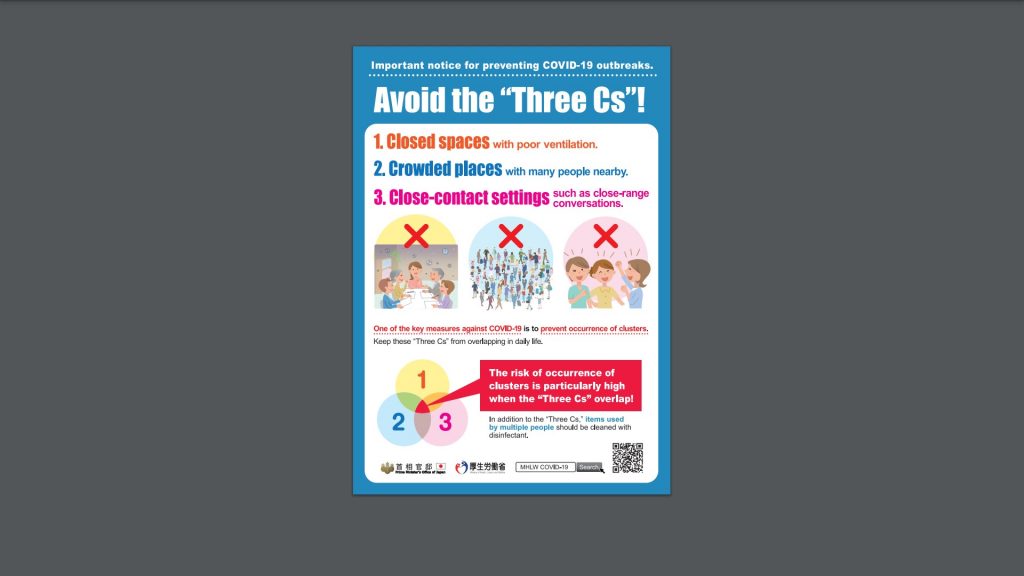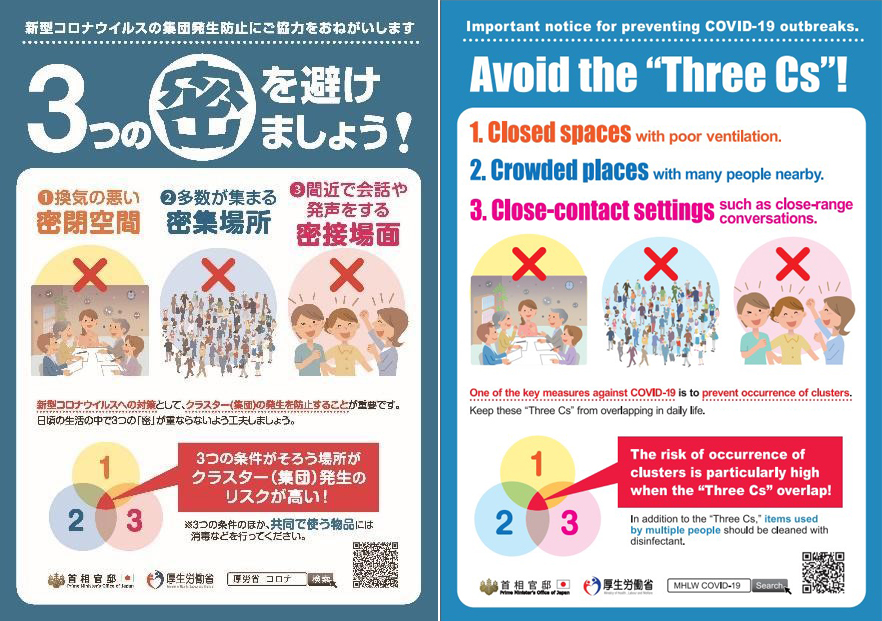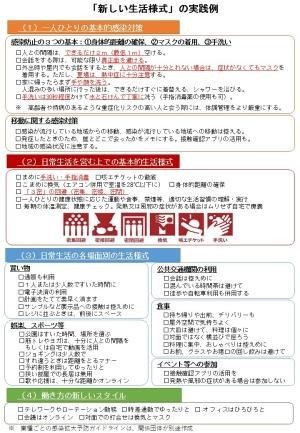3-Cs and the Three Mysteries: Japanese Esoteric Buddhism’s Response to the Covid-19 Pandemic
contributed by Yijiang Zhong, 25 September 2020

Cover Image: sourced from the Ministry of Health, Labor and Welfare of Japan Website
How does religion make sense of the Covid-19 pandemic and rearticulate its relevance for a society where close-contact social life has been drastically reduced and people primarily communicate by digital means? In formulating innovative ways to engage society during the Covid-19 pandemic, esoteric Buddhism, or Shingon in Japanese, appears more savvy than other Buddhist sects in Japan. Shingon Buddhists grasped a linguistic opportunity provided by the Japanese language to relate their doctrine to a society under voluntary quarantine. Esoteric Buddhists mobilized a homonym called sanmitsu (pronounced sanmitsu and written as 三密) to connect the basic esoteric teaching of Three Mysteries to the Japanese government’s infection prevention guideline called 3-Cs - coincidentally also pronounced and written as sanmitsu 三密. By doing so, they transformed a doctrine originally meant for Buddhist enlightenment into a teaching meaningful and useful for the new social conditions of the Covid-19 pandemic.
The 3-Cs
The Japanese government announced in late March the 3-Cs guideline as one of its key prevention measures to contain Covid-19. The 3-Cs refers to “Close contact settings (missetsu 密接),” “Closed spaces (mippei 密閉),” and “Crowded places (misshu 密集).” The 3-Cs guideline was publicized in Japanese as mitsu no mitsu in the first couple of weeks, but soon became abbreviated to sanmitsu 三密. People should avoid the 3-Cs to prevent infection of the coronavirus (Figure 1). Without ever putting the country under forced lock-down even during the State of Emergency period (April 7-May 25), the Japanese government continues to urge voluntary prevention by following the 3-Cs guideline. On May 4, authorities revealed a proposal to shift the society to a “New Lifestyle” in which humans coexist with the coronavirus (Figure 2). The 3-Cs has become the most publicized and well-known phrase related to the pandemic and has entered the daily vocabulary of the country. For example, H.I.S, one of the largest travel agencies in Japan, designed package tours to Hokkaido that strictly follow the 3-Cs guideline (Figure 3).

Figure 1: “Avoid the 3-Cs!”. Source: Ministry of Health, Labor and Welfare of Japan Website

Figure 2: “A Test Example of the ‘New Lifestyle’” Source: Ministry of Health, Labor and Welfare of Japan Website

Figure 3: “Safe Tour of Hokkaido with Counter-3-Cs Measures,” a tour plan designed in August by H.I.S, one of the largest travel agencies in Japan
The Three Mysteries
The three mysteries of esoteric Buddhism refer to the method for attaining Buddhist enlightenment. Shingon Buddhism in Japan bases its teachings on the timeless and immutable teachings of the Buddha in his dharmakaya, or cosmic body. This buddha, named Mahavairochana or Dainichi in Japanese, was felt to be beyond all earthly dualism and impurity but at the same time to be within all things as their buddha nature. In Shingon, the realization that one’s own buddha nature is identical with Mahavairochana is enlightenment. This enlightenment can be achieved in this world while possessing a human body. To achieve this enlightened state, however, the aspirant must receive the secret doctrine of Shingon orally and directly from a Shingon master.
The truth that the master reveals is founded on the ritual mysteries of the body, speech, and mind – the Three Mysteries (sanmitsu 三密). These mysteries invoke cosmic forces embodied in the buddhas and bodhisattvas with which the aspirant identifies before becoming one with Mahavairochana. The experience of the mystery of the body involves the use of mudra: devotional gestures of the hands and fingers, postures of meditation, and the handling of sacred instruments such as the vajra (“thunderbolt” or “diamond”) and the lotus. The mystery of speech involves the recitation of dharanis or mantras - mystical verses and sounds believed to be the essence of the cosmic forces with which one wishes to commune. Attaining the mystery of the mind involves yogic contemplation of and absorption in the buddha Mahavairochana and his attendants.
From the Three Mysteries to the 3-Cs
From April, Shingon Buddhist priests, most of them temple abbots, started talking about how the seemingly different Three Mysteries and the 3-Cs are actually closely related. This new sanmitsu teaching is popularized by the abbots on Facebook, Twitter and is also seen on temple websites, Buddhism-related popular websites (e.g. Maitera Shimbun and Hotokami), non-Buddhist mainstream newspapers, blogs of various types as well as websites of businesses and medical doctors. As seen, Sanmitsu teaching can be found on the websites of six temples; four of Shingon Buddhism (Jizoin Temple, Jutoku-ji Temple, Kongo-Ji Temple and Jifuku-Ji Temple) and one on Zen Buddhism which discusses this Shingon teaching. Some examples of newspapers covering this phenomenon are the Tokyo Shinbun, the national Asahi Shinbun, and Chunichi Shinbun (covering central Japan).
The most elaborated version of the sanmitsu teaching is by Matsumura Myōnin, the female abbot of Jutoku-ji Temple in Fukushima Prefecture, who authored a hardcopy leaflet, as shown in the photo below. I will briefly introduce her version here as the representative of the new sanmitsu teaching.

Figure 4: Matsumura Myōnin, abbot of Jutoku-ji Temple in Fukushima Prefecture
According to abbot Matsumura, cultivation through body/action, speech, and mind (the Three Mysteries) is fundamentally important for Shingon Buddhism. It can lead to a peaceful mind and balanced life. This is a sanmitsu that we want to observe for the sake of our heart. Now there is another sanmitsu that we however want to avoid for the sake of the society and our health. So what does Shingon Buddhist cultivation mean in the current society experiencing the Covid-19 pandemic?
This is what Abbot Matsumura recommends: in terms of action, we want to adjust our behavior in view of what is important at this very moment and not act just for our own interest. Personal hygiene should be emphasised amidst this pandemic as individuals are encouraged to wash their hands regularly and cleanse their bodies. In addition, self care is not to be neglected as well: one should move/exercise the body within limits, smile once a day, take enough nutrition and get sufficient sleep.
In terms of speech, it is important to rectify our own words and not to say anything negative about others (including on online platforms). One should not take advantage of others’ mistakes and instead spend more time chatting on the phone to reduce stress. She also recommends rinsing one’s mouth regularly.
Last but not least, in terms of thinking, we should spend one minute looking at our own heart/mind to find our true self. We should not let the amount of incoming information control our heart/mind. Try what you can do to enrich your heart and relax yourself; breathe deeply to pacify your heart.
This is how abbot Matsumura brought the Shingon Three Mysteries into relation with the 3-Cs guideline. The formulation is creative, natural, and practical in bridging the distinctions between body and mind, and self and others. By redefining the Buddhist goal of enlightenment to be the attainment of a peaceful mind and balanced life, it shows how a doctrine meant first for enlightenment and personal liberation can be reinterpreted as a meaningful model of socialization for a modern, digitized society suffering from an unprecedented pandemic.
Yijiang Zhong is associate professor in Japanese history and religion at the Institute for Advanced Studies on Asia, the University of Tokyo. His research interests include religion and secularity, religion and modern state, history of the Japanese empire, history of space and nature. He published a book on Shinto and is now working on the second book project tentatively titled "Ura-Nihon: An Imperial History of Space in Northeast Asia, 1868-1984".
Disclaimer: The views and opinions expressed in this article are those of the authors and do not necessarily reflect the position of the blog editorial team or the Asia Research Institute.
South Asia | Southeast Asia | East Asia | Other Places | Hinduism | Buddhism | Islam | Christianity | Other Religions

